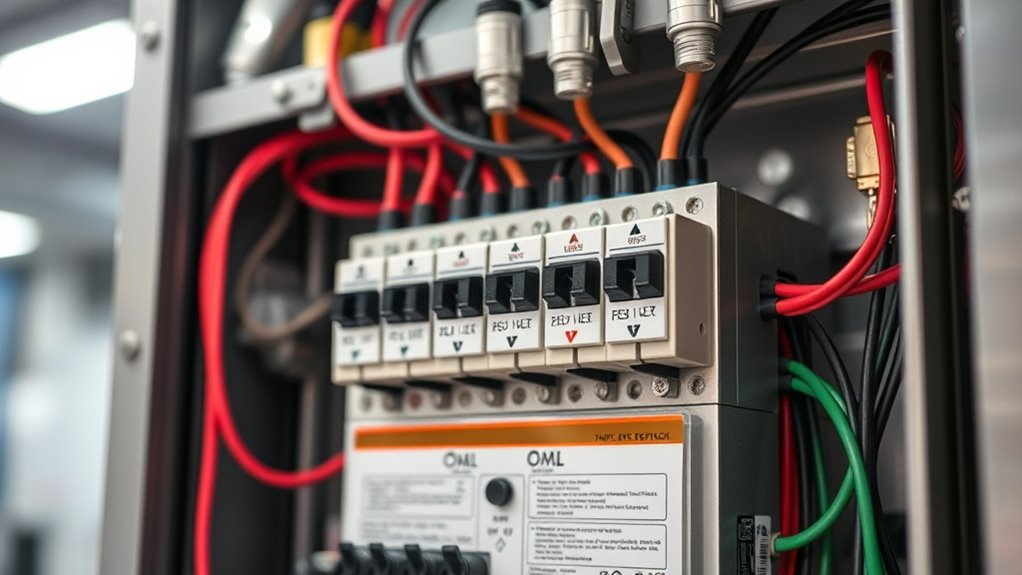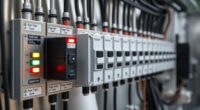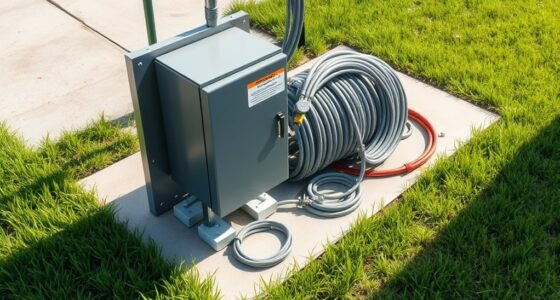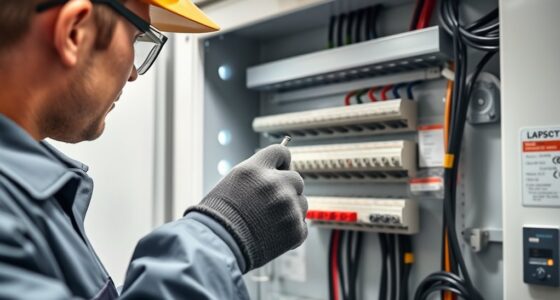To comply with NEC requirements for transfer switches, you need to make certain proper sizing to match your load, with correct installation in accessible, safe locations. You must follow rules for wiring, grounding, and labeling to meet code standards. Testing the switch regularly confirms safe operation during outages, and documentation is essential. Maintaining these standards helps prevent hazards and ensures dependable power transfer—continuing further will show you how to implement these standards effectively.
Key Takeaways
- Transfer switches must be properly rated and installed per NEC standards to ensure safe power transfer during outages.
- Adequate clearance, accessibility, and proper wiring, grounding, and labeling are required for compliance.
- Testing procedures should verify mechanical and electrical operation, with documentation maintained for inspection.
- Transfer switches should be installed in locations promoting safety, maintenance access, and minimizing hazards.
- Load calculations and proper sizing are essential to prevent overloads and ensure reliable system performance per NEC guidelines.

Are you aware of the key NEC requirements that govern transfer switches? Understanding these standards is essential to guarantee your system operates safely and reliably during power outages. The National Electrical Code (NEC) emphasizes proper installation, sizing, and testing to prevent hazards and ensure compliance. One important aspect is generator sizing, which must be carefully calculated to match the load it will serve. An undersized generator can struggle to supply power during peak demand, risking damage to the equipment or complete failure when it’s needed most. Conversely, an oversized generator may be inefficient and more costly, but it’s vital to select a unit that aligns with the load calculations outlined in the NEC. This involves evaluating the total connected load, starting currents, and any surge requirements. Proper generator sizing not only guarantees reliable operation but also helps in adhering to safety standards, preventing overloads, and reducing the risk of electrical fires.
In addition to accurate sizing, the NEC mandates thorough testing procedures for transfer switches before they become operational. Testing is vital to verify that the transfer switch functions correctly, safely isolates circuits, and properly transfers power between sources. The NEC requires that testing procedures include verifying the mechanical and electrical operation of the switch, ensuring it can handle the rated load without issues. You should simulate power transfer scenarios, both manual and automatic, to confirm that the switch responds appropriately under different conditions. These tests must be documented, and any faults identified should be addressed before the transfer switch is put into service. Regular testing, as prescribed by the NEC, helps you catch potential problems early, ensuring the safety of personnel and the protection of connected equipment. Additionally, proper installation practices are critical to ensure that the system remains compliant and operates as intended over time.
Furthermore, compliance with NEC requirements involves ensuring that the transfer switch is installed in a location that permits safe operation and maintenance, with adequate clearance and accessibility. Proper wiring, grounding, and labeling are also critical to meet code standards. By paying close attention to generator sizing and adhering to rigorous testing procedures, you can maintain a resilient backup power system that not only meets legal standards but also provides peace of mind during emergencies. Ultimately, understanding and implementing these NEC requirements will help you avoid costly violations and guarantee your transfer switch performs flawlessly when you need it most.
Frequently Asked Questions
How Often Should Transfer Switches Be Inspected or Tested?
You should inspect and test your transfer switches at least annually to guarantee proper operation. Follow regular maintenance schedules and adhere to specific inspection procedures outlined by the manufacturer. Periodic testing helps identify potential issues early, preventing failures during power outages. Keep detailed records of inspections and tests, and promptly address any problems found to maintain safe, reliable transfer switch performance and comply with safety standards.
Are There Specific Labeling Requirements for Transfer Switches?
You should guarantee your transfer switches meet specific labeling standards, which include clear identification of the switch type, ratings, and manufacturer details. The labels must be durable and legible, complying with certification requirements set by the NEC. Proper labeling helps in quick identification during inspections, maintenance, or emergencies, ensuring safety and compliance. Always verify that your transfer switches are correctly labeled according to these standards before installation or use.
Can Transfer Switches Be Installed Outdoors Without Additional Protection?
Yes, you can install transfer switches outdoors, but you need to use weatherproof enclosures to protect them from the elements. These enclosures prevent moisture, dust, and debris from damaging the switch, ensuring safe and reliable operation. Make sure the enclosure is rated for outdoor use, and follow manufacturer instructions for proper installation. Proper outdoor installation helps maintain safety and compliance with NEC requirements.
What Are the Common Troubleshooting Steps for Transfer Switch Malfunctions?
Troubleshooting transfer switch troubles starts with careful diagnostics and diligent procedures. First, check connections, ensuring they’re secure and corrosion-free. Next, reset the switch to see if it clears the problem. Test for power flow and verify circuit breakers are functional. If issues persist, inspect for physical damage or faults. By methodically diagnosing and diligently following troubleshooting procedures, you’ll quickly identify and resolve transfer switch malfunctions, restoring reliable power transfer.
Are There Any Recent Updates to NEC Standards for Transfer Switches?
Recent updates to transfer switch standards emphasize enhanced safety and reliability. You should verify that your transfer switches meet the latest NEC compliance, specifically regarding automatic transfer switch (ATS) requirements and grounding protocols. Newer standards may also specify improved testing procedures and inspection intervals. By staying current with these NEC updates, you guarantee your transfer switches operate safely and efficiently, reducing risks and maintaining code compliance in your electrical system.
Conclusion
Understanding NEC requirements for transfer switches helps make certain your system is safe and reliable. Did you know that properly installed transfer switches can prevent up to 80% of electrical fires caused by improper connections? By following these guidelines, you not only protect your property but also keep your loved ones safe. Keep these requirements in mind during installation, and you’ll be well on your way to a secure and dependable power backup system.









